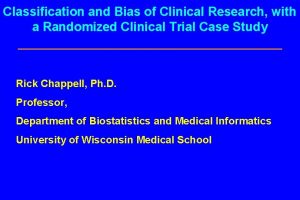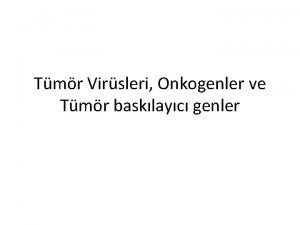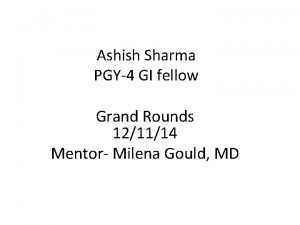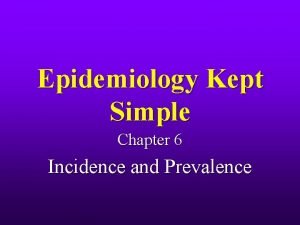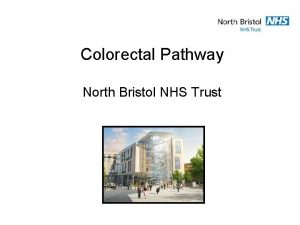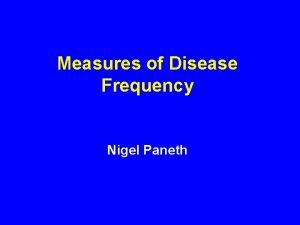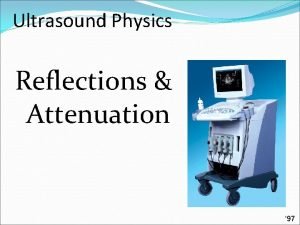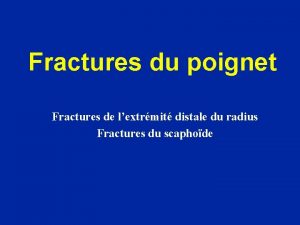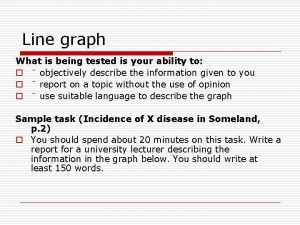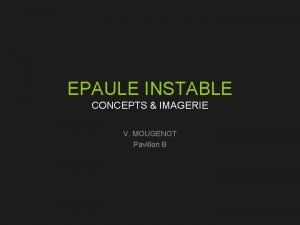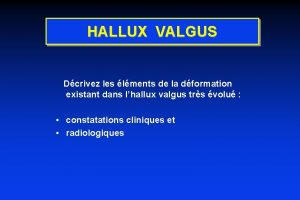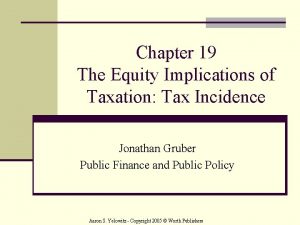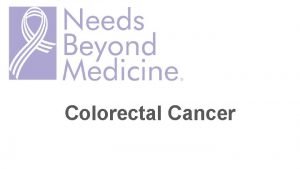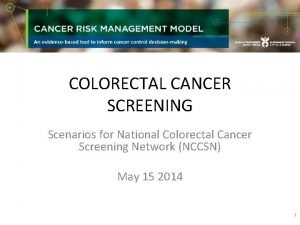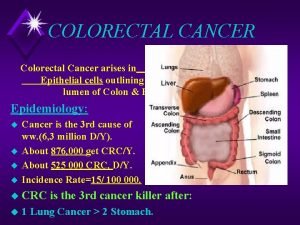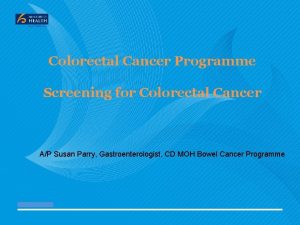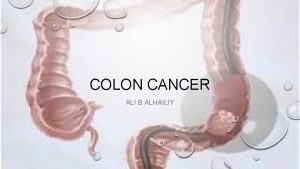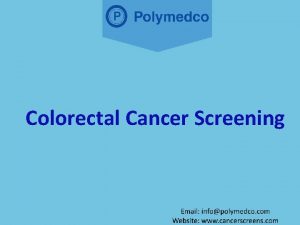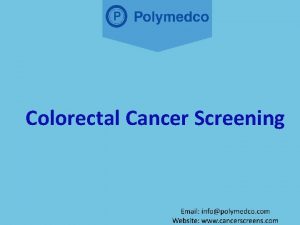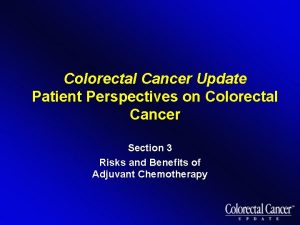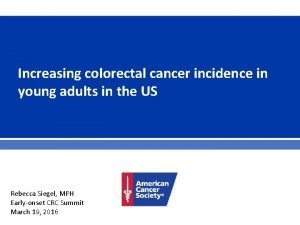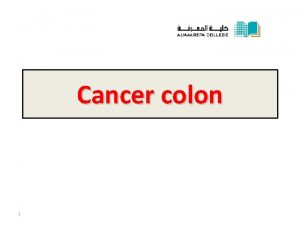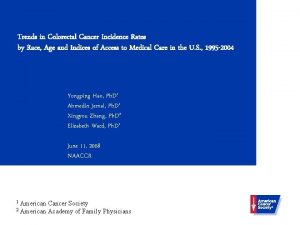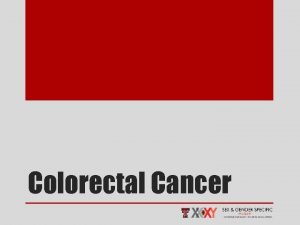COLORECTAL CANCER COLORECTAL CANCER n Incidence n n




















- Slides: 20

COLORECTAL CANCER

COLORECTAL CANCER n Incidence n n n 2 nd after bronhopulmonary C in males and breast in females >65 ani M: F=1 -1, 5: 1

n n RISK FACTORS n Precancerous status Food habits Ulcerative colitis Excess of animal fat and colesterol Lack of fibers in food Excess of salt, spicy, smoked mea, alcohol, food additives n n n Heredity n n Some diseases with heredia=tary component – increased risk of cancer: n n Ulcerative colitis; Poliposis colli Adenomatous polips. There are families with increased incidence of colorectal cancer NPCC 15 times higher risk then rest of population Higher risk if: : n n Onset in childhood Longer then 19 years evolution Malignant degeneration ~3040 y much earlier then sporadic cancer Often multiple cancer – synchronous Adenomatous polypes – specially >2 cm FAP – certain cancer after 1520 y Crohn’s 10 y of evolution in patients with onset below 21 y

Pathology More often sigmoid colon – logic of sigmoidoscopy n Most often single tumors, but multiple synchronous or metachronous tumors are not unusual n

n MACROSCOPY n n a) exofitic –cauliflower like b) schirous n n c) coloide (mucinous): n n Major hyperplasie of fibroconjunctiv tissue Circular development – stenosis Fmore often left side Proiferation of mucinous cells; Soft, friable, bleeding Often right side, young patients d) ulceration

Pathology n Microscopy: n n adenocarcinoama: cylindric epithemlium Carcinoid tumors – very unusual; Epidermoid carcinoma– exceptional; Sarcoama

n a) direct: n n Spread pathways In the wall – serosa – ajacent organ In the surface: n n Along submucosal layer n b) lymphatic: n transperitoneal: Most often Intraperietal – local – regional lymph nodes n Colic veins – portal system – lver MTS Lombar and vertebral veins – pulmonary MTS Neoplastic cells get detached and reseaded (anastomotic recurrences). n e) n T 4 a – exposure to the serosa n n c) Vascular: n d) intraluminal: n circumferential; longitudinal: n n n Douglas pouch Omentum Peritoneal carcinomkatosis f) perineural: .

n n Stadiul 0 Stadiul III n Stadiul IV Tis T 1 T 2 T 3 T 4 any T Staging N 0 N 0 N 0 N 1 N 2, N 3 any N M 0 M 0 M 1 Dukes A B C

SYMPTOMS n Changes in bowel habit n n n Constipation Diarrhea !alternation of constipation with diarrhea) Dependent on location of the colon n n n From discomfort to colicky Aggressive peristalsis above the tumor n n n Borborism Meteorism Can suggest the location Location of pain: n n n RLQ – distension of cecum; Epigastric – often in transverse colon cancer; RUIQ lombar – may creat confusion n occult melenar; Hematochezia Other synptoms: n Pain n Bleeding ~ gastric problems ~ billiary symptoms ~ urinary syptoms General signs : n anorexia, weight loss, low fever

Clinical examination n Often negative n GENERAL; n general: n Palor, apathy, diminshed turgor n Cachexia – advanced stages n LOCAL n Nothing n Tumor n Ascitis n Hepatomegaly n Rectal/vaginal : n Sigmoid tumors falling in the pouch of n Carcinomatosis. Douglas;

n Non specific LAB Anaemia (microcytis, hypochromic) ; n Increased ESR n leucocitosis n Abnormal liver tests n n CEA Not for diagnostic purpose; n Only high values are significant for C colon, stomach, pancreas. Normal value do not have significance n More valuable for post therapy follow up n Occult blood test: screening ? ? ? n Colic cytology n

X-Ray n Corect dg in 90% n Plain X-Ray in complications n Barium enema n Wall rigidity n Filling defects. n Stenosis – golf trousers n Ulcerations

n Colonoscopy n n Biopsy Treatment

Echoendoscopy CT MRI US scan

Virtual CT colonoscopy

Evolution and complications 1. Obstruction: n Left colon and rectum n Incomplete obstruction to acut obstruction n Typical presentation 2. Perforation: a) extension through the wall; n b) diastatic: n c) juxtatumoral. n

3. Septical: n n Abscess formation; Peritonitis 4. Fistula: n n exterior – piostercoral fistula Other organ; 5. Volvulus 6. Invagination 7. Compression 8. Invazia organelor învecinate: 9. Anemia: 10. Metastasis

TREATMENT n Surgical: - tumor, lymph nodes, regiomal lymphnodes +/invadet organs n Radical – oncologic colectomy with regional

n Paliative: n 1. by pass: 2. diverting stoma 3. stents n n

n Tratament endoscopic
 Colorectal cancer drug trial
Colorectal cancer drug trial Colorectal cancer
Colorectal cancer Amsterdam criteria
Amsterdam criteria Incidence vs incidence rate
Incidence vs incidence rate Attack rate formula
Attack rate formula Ann lyons colorectal surgeon
Ann lyons colorectal surgeon Adenoma
Adenoma Incidence vs prevalence
Incidence vs prevalence How to calculate cumulative incidence example
How to calculate cumulative incidence example Perpendicular incidence
Perpendicular incidence Period prevalence formula
Period prevalence formula Fracture salter 2 poignet
Fracture salter 2 poignet Incidence of x disease in someland
Incidence of x disease in someland Profil de coiffe de lamy
Profil de coiffe de lamy Recessus sous labral
Recessus sous labral Oriented incidence matrix
Oriented incidence matrix Owasp cloud incidence analysis and forensic
Owasp cloud incidence analysis and forensic Incidence de guntz definition
Incidence de guntz definition Logic and incidence geometry
Logic and incidence geometry Consumer incidence
Consumer incidence Rumus sex ratio
Rumus sex ratio
